July 1, 2016
Air Date: July 1, 2016
FULL SHOW
SEGMENTS

Republicans Vote to Block Military Climate Planning
View the page for this story
House Republicans move to block Defense Department’s efforts to prepare for climate change with an amendment attached to the defense spending bill. Living On Earth Host Steve Curwood sat down with former DoD Deputy Undersecretary Sherri Goodman for her views on the need for Pentagon to assess the national security threats of global warming. (08:25)

Beyond the Headlines
/ Peter DykstraView the page for this story
Host Steve Curwood and Peter Dykstra discuss possible environmental regulatory fallout of the UK’s Brexit vote, repercussions of the recent “once in a thousand year” floods in West Virginia and reflect on the widespread impact of the Federal Highway Act of 1956 on American culture and lifestyle. (04:25)
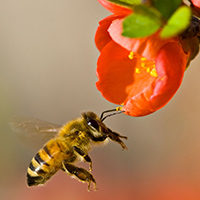
Emerging Science Note: Backyard Garden Threat to Bees
/ Jay FeinsteinView the page for this story
: Pesticides are a leading contributor to recent widespread declines in honeybee populations. But don’t blame farmers. As Living on Earth’s Jay Feinstein reports in this note on emerging science, a new study in Nature magazine found a large amount of bees’ pesticide exposure came from non-cultivated areas, including backyard gardens. (02:00)
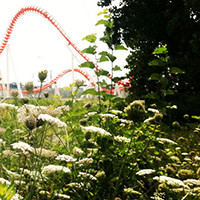
The Value of Weeds
/ Helen PalmerView the page for this story
Landscape architect David Seiter is on a mission to emphasize the aesthetic and environmental benefits of what he calls spontaneous urban plants, but what most of us call weeds. David Seiter takes Living on Earth’s Helen Palmer on a tour of Red Hood, Brooklyn, showing off the mugwort and Queen Anne’s Lace and Tree of Heaven that sprout up through and along the sidewalks in this post-industrial neighborhood, and explains their value for cooling the city, conserving water and sequestering carbon. (13:50)
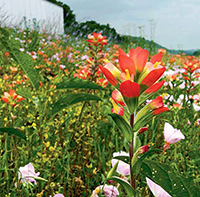
Roadsides as Vital Habitat
View the page for this story
Some 17 million acres of green space line US highways and byways, and it’s vital habitat for pollinators, as well as small voles and mice and birds. Bonnie Harper-Lore, a restoration ecologist formerly with the Federal Highway Administration, tells host Steve Curwood about the value they offer to wildlife and how President Lyndon Johnson’s wife, Ladybird, helped uplift this elongated haven for creatures and wildflowers. (07:55)
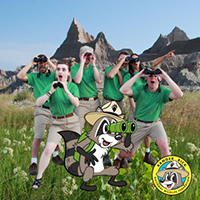
Whizpops: Teaching Science to Kids
View the page for this story
The Whizpops, an award-winning band of teaching artists and musicians from Missoula Montana, recently released their fourth album, Ranger Rick’s Trail Mix Vol. 1. The group collaborated with the National Wildlife Federation to try to raise awareness of some of more than 2,000 endangered species listed under the U.S. Endangered Species Act through catchy songs calculated to appeal to kindergartners. Host Steve Curwood speaks to Whizpops bandleader Casey Schaefer and listens to some of their music. (10:25)
Show Credits and Funders
Show Transcript
HOST: Steve Curwood
GUESTS: Sherri Goodman, David Seiter, Bonnie Harper-Lore, Casey Schaefer
REPORTERS: Peter Dykstra, Jay Feinstein, Helen Palmer
[THEME]
CURWOOD: From Public Radio International, this is Living on Earth.
[THEME]
CURWOOD: I'm Steve Curwood. The Pentagon sees global warming as a threat multiplier, but Republicans in the House deny funding to help the military prepare for climate change.
GOODMAN: Unfortunately in our own country, particularly in the halls of Congress, climate is a lightning rod. So if you re-frame the issue as one of improving military readiness, reducing risk, and increasing resilience, I think you can achieve the same result.
CURWOOD: What’s at stake in global hot-spots and here at home. Also, teaching science to kindergartners – through music.
SCHAEFER: Every year at least three or four kids beg for a guitar for Christmas, and they’ll bring their guitar in and they’ll play for the class, and we just have a really fun time with it.
CURWOOD: Songs of nature and more this week, on Living on Earth. Stick around.
[NEWSBREAK MUSIC: Boards Of Canada “Zoetrope” from “In A Beautiful Place Out In The Country” (Warp Records 2000)]
Republicans Vote to Block Military Climate Planning

The Pentagon has headed up research at the intersection of national security and climate change since the second Bush administration. (Photo: David B. Gleason, Flickr CC BY-SA 2.0)
[THEME]
CURWOOD: From the Jennifer and Ted Stanley studios at the University of Massachusetts Boston and PRI, this is Living on Earth. I’m Steve Curwood.
Since the George W. Bush Administration, the Department of Defense has been warning that climate change poses a threat to national security and in January, Pentagon officials proposed to update their climate threat assessments in response to a directive from President Obama. But in June, House Republicans voted to block the Defense Department from spending money for climate planning.
The measure was sponsored by Colorado Republican Ken Buck, who was unavailable to speak to Living on Earth. His staff referred us to his statement posted on his website. It reads in part: “The military, the intelligence community [and] the domestic national security agencies should be focused on ISIS and not on climate change. The fact that the president wants to push a radical green energy agenda should not diminish our ability to counter terrorism.”
For analysis, we called up Sherri Goodman, a former Deputy Undersecretary of Defense for Environmental Security and now at the Woodrow Wilson Center in Washington. Sherri Goodman, welcome to Living on Earth.
GOODMAN: Pleasure to be here, Steve.
CURWOOD: So, I'm puzzled here. What has happened that the House of Representatives would vote to stop the Pentagon from engaging with what it has said is a key part of its mission – that is, protecting the national security of the United States?
GOODMAN: Oh, it's simply a reflexive anti-climate vote without understanding the detrimental impact it'll have on our troops, training, and our military readiness. I think if the members really had a chance and an opportunity to hear from our military leadership about how it protects readiness, not undermines it, how it reduces cost, not raises it, I believe they would have a different view.

Climate change poses a risk to soldiers who are stationed in locations like the Middle East, where temperatures are already blistering. (Photo: The U.S. Army, Flickr CC BY 2.0)
CURWOOD: Now, of course, people right now feel that the military needs to focus on ISIS and other terrorist groups. How does the Pentagon justify spending money on climate change for those skeptics on Capitol Hill who concerned about that?
GOODMAN: I don't think of it as spending money on climate change. I think of it as investing to protect our troops when they train, when they deploy and when they're stationed at our military bases. As a mother, I want my son or daughter to be protected from the health risks of higher temperatures that our troops are encountering when they deploy to places like the Middle East which has now reached 140 degree temperature. I want to my son or daughter to be projected when our military bases are affected by sea level rise and coastal subsidence. And as a taxpayer, I want my military to be energy efficient, and I want it to be energy resilient and to protect us against outages caused by the next storm, and that's what these amendments are preventing us from doing.
CURWOOD: Now, to what extent does the Pentagon see climate disruption playing into the severe difficulties in the Middle East? I'm thinking of Syria, I'm thinking of ISIS, and Africa as well.
GOODMAN: Well, underlying the Syrian crisis is prolonged drought that led to the food crisis that produced the uprisings of the Arab spring. So, drought underlines exacerbated conditions that lead to extremism, terrorism, and the changing politics we've seen in this region. At the same time, we're seeing increased what the military calls “demand signal” to respond to humanitarian relief and natural disasters as more of those occur around the world. And so, the Pentagon and our military need to be prepared to respond to a wider variety of conditions.
CURWOOD: So, what exactly did the House vote to defund?
GOODMAN: Steve, it blocked funding associated with implementing executive orders, some of which go back to President Bush, that are bipartisan efforts establishing goals across the federal government for energy security, conservation, climate resilience, and sustainability.
CURWOOD: So what are the risks that might occur if the military doesn't conduct this research?
GOODMAN: Well, those risks, Steve, are that we wouldn't fully be able to understand the implication of rising sea levels and coastal erosion at our military installations around the country, one. Two, that we won't understand the impacts of drought which are already affecting our bases and our military's ability to train at key installations in the Southwest from Arizona to Colorado – And finally, our ability to respond in the Arctic. You know, we are just recognizing that we need now with a more aggressive Russia to be able to have the military capability to operate in the Arctic, and the Arctic is changing faster than any region on the planet, a combination of ice melt, permafrost melt. And in order for our military and our Coast Guard to operate in that region they need to understand those conditions. It's like going to sea with your eyes blind.
CURWOOD: Now, what does terminology have to do with this situation? What I'm thinking of is the Navy – you know – it cuts fuel costs by upgrading its energy program, and in those proposals they never said climate change and that seemed to sail right through Congress. Your thoughts?

From 1993 to 2001 Sherri Goodman served as Deputy Undersecretary of Defense for Environmental Security, the Pentagon's chief environmental, safety, and occupational health officer,. (Photo: Woodrow Wilson Center)
GOODMAN: Well, yes, of course, Steve. You're in the business of words, so you know that words matter. And often unfortunately in our own country, particularly in the halls of Congress, climate is a lightning rod. So if you re-frame the issue as one of improving military readiness, reducing risk, and increasing resilience, I think you can achieve the same result.
CURWOOD: Okay. So, there's a floor vote yet to come in the Senate on this issue. I know you probably don't have a crystal ball there, but what's your best guess as to how you see the senate vote going on this?
GOODMAN: You know, Steve, I don't want to speculate on that, but I do firmly believe that congressional defense leadership on armed services and defense appropriations will appreciate that our forces need to be able to understand how to operate at the risk of higher temperatures. I mean these findings, you know, they are widely known. The Defense Science Board reports about them. There've been numerous intelligence committee studies. So, in fact, this is just responsible planning.
CURWOOD: Sherri, what about here at home? What does the Pentagon say might be needed in terms of use of the military to deal with the effects of climate disruption here in the United States as we see crazier and crazier floods and fires and such?
GOODMAN: Well, thank you for asking that, Steve, and Super-storm Sandy, you know, our military was called basically, you know, as the backup force. We had army engineers, colonels who were responsible for turning the electricity back on in New York City. I talked to one officer who told me, “well, I learned about doing that from my deployments in Iraq.” And so we're increasingly seeing our own military have to provide defense support to civil authorities for incidents occurring at home ranging from Super-storm Sandy to Katrina to wildfires in the West. Our military is there and we want it to be there when those civil authorities need additional support – but to do that we have to understand what those changing conditions are and be able to, first, reduce the risk because we like not to have extreme wildfires or extreme weather events if possible and then in anticipation of them occurring, we, of course, need to train and equip our forces to be able to respond.
CURWOOD: So, how much of this is a done deal or is there a chance for this to nonetheless get approved by Congress?
GOODMAN: I don't think it's a done deal at all. I think there's an opportunity for the Senate position to prevail and I think this will be an important item for deliberation in the conference.
CURWOOD: Sherri Goodman is former Deputy Undersecretary of Defense for Environmental Security. She is now a fellow at the Woodrow Wilson Center in Washington, DC.
GOODMAN: Thanks so much, Sherri. Thank you, Steve.
Related links:
- 2016 Pentagon Climate Directive
- Amendment Vote Results
- Congressman Ken Buck’s Full Press Release
- Online Bio For Sherri Goodman
- Bush Administration Climate Change Reports
Beyond the Headlines

As the world prepares for the realities of “Brexit,” environmental policies in the UK have an uncertain future. The European Union’s strict regulations were likely a factor in British voters’ decision to exit the bloc. (Photo: Diamond Geezer, Flickr CC BY-ND 2.0)
CURWOOD: Let’s head to Conyers, Georgia, now to catch up with Peter Dykstra and the stories beyond the headlines. Peter’s with Environmental Health News, that’s EHN.org and DailyClimate.org. Hey, Peter, how are you doing today?
DYKSTRA: Hi, Steve. I’ve got myself a little summer cold so I’ll be a little hoarse today. But you know it was a tough week or so for England. A few days before England got knocked out of the European Cup soccer tournament by tiny Iceland, UK voters chose to knock themselves out of the European Union.
CURWOOD: And immediately after, world stock markets took a dive and some UK voters began, shall we say, voicing second thoughts?
DYKSTRA: Yeah, speculation is rampant, not very much of it optimistic, but let’s take a look at the EU’s role as a global environmental regulator.
When the EU tightened its air pollution standards in 2010, the UK was forced to go along, though it’s still not in full compliance. Tight EU restrictions on everything from farming to ocean pollution, fishing to chemicals, had drawn fire from the two political leaders most widely identified with the successful Brexit vote – that’d be Boris Johnson and Nigel Farage.
CURWOOD: So when the UK actually takes itself out of the EU, does that mean that the EU’s stronger environmental protections are going to be out?
DYKSTRA: We don’t know yet, but resentment toward some EU policies probably helped tip the scales on the Brexit vote. One example: The UK National Farmers Union bristled when the EU set a ban on neonicotinoid pesticides, widely believed to contribute to the collapse of bee populations.
CURWOOD: So there are a lot of question marks about how Britain’s leaving the European Union and will drive policy in both the UK and EU. What do you have next for us, Peter?
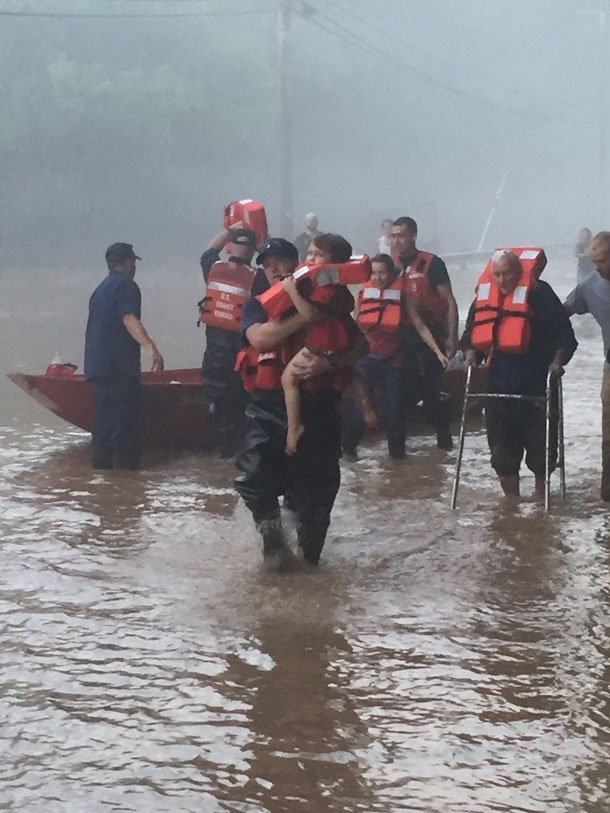
The Coast Guard responded to devastating floods in West Virginia last week, yet another thousand-year weather event to hit the country in recent years. (Photo: Lora Ratliff, Flickr CC BY-ND 2.0)
DYKSTRA: The devastation from West Virginia’s recent floods was extraordinary. A parade of heavy downpours led to abrupt flooding in the state’s narrow, steep-hilled valleys, killing around two dozen with more reported missing and driving thousands more from their homes in what was described as a “once in one thousand years” flooding event.
CURWOOD: Hmmm, it seems there have been a lot of thousand-year events lately.
DYKSTRA: Right, and in the face of tragedy, here’s a little perspective, courtesy of West Virginia’s biggest newspaper and one of the state’s biggest annual events. The Charleston Gazette, which has probably lost a few readers or advertisers for speaking plainly in this traditionally coal-dependent state, said this: “In the aftermath of West Virginia’s flood tragedy, it’s a time to grieve for the dead and shelter multitudes of families who lost their homes, jobs and possessions. But later, after the immediate crisis is past, conscientious people should think about causes of devastating weather.”
Over at the Greenbrier, the lavish mountain resort, the hotel is shuttered and the gleaming fairways of its championship-caliber golf courses are digging out from three feet of mud instead of hosting one of the premier professional golf tournaments this coming weekend.
CURWOOD: Which is not to say that a closed down resort and golf tournament are more important than the loss of lives and homes.
DYKSTRA: Not at all, but this coming weekend, when millions of sports fans tune in to the see the weekly PGA Men’s tournament and it’s not there, maybe it’s one more reason to think about the weather, the climate, and the seeming changes all around us.
CURWOOD: Hey, Peter, what do you have from the annals of history for us today?
DYKSTRA: Sometimes it’s the things we don’t think of as environment-related that have the biggest environmental impacts. Sixty years ago this past week, President Dwight Eisenhower signed the Federal Highway Act of 1956, creating the Interstate Highway System we all know and love today, except maybe when we’re stuck in traffic on it or are pondering the environmental impacts of it all.
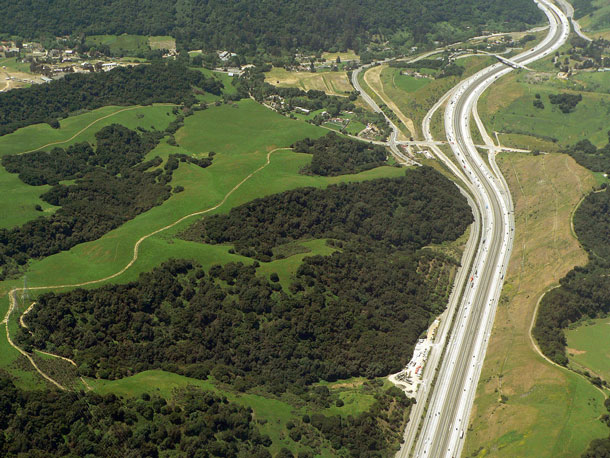
Sixty years ago, President Dwight D. Eisenhower signed the Federal Highway Act and fundamentally changed the way we live, move, and build. (Photo: Walter Siegmund, Wikimedia Commons CC BY 2.5)
CURWOOD: Yeah, and the interstates really sealed the deal for America as a car-dependent culture.
DYKSTRA: Yes, and although its nearly 48,000 miles were declared complete in 1991, guess what...we’re still building it. In June, the final section of Interstate 22 was completed near Birmingham, Alabama.
But let’s a step back and look at the system’s impacts, good and bad: interstate highways pretty much stuck a fork in passenger rail, and much of our freight rail traffic; it contributed to suburban sprawl and the draining of core cities.
If your town was on an interstate route...instant bonanza. If the freeways passed you by, like the Bates Motel in the movie Psycho, things got a little bad. So the interstates really made deep changes in not just how we live, but where we live and how we get around.
CURWOOD: Not to mention a huge invitation to increase our carbon footprint. Peter Dykstra is with Environmental Health News – that’s EHN.org and DailyClimate.org. Thanks, Peter. We’ll talk to you again soon.
DYKSTRA: Okay, Steve, thanks a lot. Talk to you again soon.
CURWOOD: And there’s more on these stories at our website, LOE.org.
Related links:
- UK National Farmers Union and neonicotinoids
- Mother Jones: “Why Brexit is Bad News for the Environment”
- Independent: “Will Brexit help or damage the environment?”
- USA Today: “Why the WV floods were so deadly and destructive”
- Greenbrier golf resort under 3 feet of mud after West Virginia floods
- Charleston Gazette-Mail editorial: “Nature ravages as weather warms”
- Eisenhower signs Federal Highway Act of 1956
- Interstate 22 finally connects Birmingham and Memphis
[MUSIC: Afro Celt Sound System, “Amber,” Volume 2: Release, Simon Emmerson/James McNally/Iaria O’Leonaird/Martin Russell/N’Fayly Kouyate, Real World Records]
CURWOOD: Just ahead...pesticides can be bad for bees, but the biggest threats don’t seem to come from farmers. Stay tuned to Living on Earth.
ANNOUNCER: Support for Living on Earth comes from the Gordon and Betty Moore Foundation, and from a friend of Sailors for the Sea, working with boaters to restore ocean health.
[CUTAWAY MUSIC: Philharmonic Sinfonietta Berlin/Ion Marin with Han Na Chang, “The Flight Of the Bumblebee,” Nicolai Rimsky-Korsakov, https://www.youtube.com/watch?v=cdGwOmijRJ4]
Emerging Science Note: Backyard Garden Threat to Bees

There are fewer than 10 different honeybee species -- a fraction of the 20,000 known species of bees. (Photo: Louise Docker, Wikimedia Commons CC BY 2.0)
CURWOOD: It’s Living on Earth, and I’m Steve Curwood. In a minute, one man’s weed is another’s urban pioneer, but first this note on emerging science from Jay Feinstein.
[SCIENCE NOTE THEME]
FEINSTEIN: 80 percent of pesticides used in the U.S. are sprayed on agricultural sites, according to the EPA. Environmental advocates often argue this is partly responsible for the recent widespread decline of honeybees. Yet, a new Purdue University study suggests that key to helping save these vital pollinators is what we do in our own backyards.
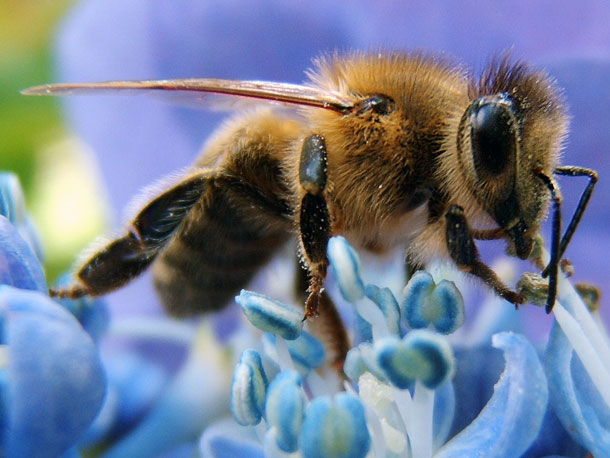
The Western Honey Bee, also known as the European Honeybee, is the most common honeybee worldwide. (Photo: Ricks, Wikimedia Commons CC BY-SA 3.0)
Scientists found that contrary to popular belief, most of the pesticide-ridden pollen bees gather may be from urban landscapes and non-cultivated plants. For 16 weeks, researchers collected pollen from bees at three different sites in Indiana and analyzed it for pesticides. They chose locations with wildflowers, shrubs and trees to test non-agricultural sites. Then, they tested different sites at the border of maize fields in areas that received chemical treatments such as the neonicotinoid Clothianidin and finally areas that received no treatments.
The researchers found that bees collected a much larger amount of pollen from the non-cultivated plants than from the food crops and that the samples from these uncultivated areas also contained a larger amount of pesticides. This suggests that pesticide exposure for bees in non-agricultural sites may be higher than previously thought and they found that pyrethroid insecticides, commonly used by homeowners to kill pests like mosquitoes, were present in the largest quantities and also likely cause the most harm to bees.
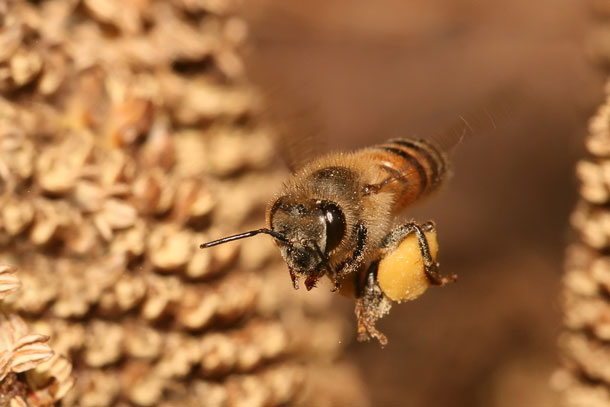
A Western Honey bee bringing pollen back to its hive. (Photo: Muhammad Mahdi Karim, Wikimedia Commons GFDL 1.2)
The scientists note that these results provide important information on bee foraging habits and bee hazards, along with tips gardeners might consider when treating their yards.
That’s this week’s Note on Emerging Science. I’m Jay Feinstein.
[SCIENCE NOTE THEME]
Related links:
- The Nature article about the study
- An information sheet about pesticide use which includes EPA statistics about the amount used in agriculture
- Listen to a previous LOE report on how pollinator declines impact public health
- National Geographic: The Last, Best Refuge for North America’s Bees
The Value of Weeds

Daucus Carota or Queen Anne’s Lace (Photo: Future Green Studio)
CURWOOD: Summer city dwellers are grateful for the green shade of street trees, the cool refuge of parks and the glimpses of front yards and planters. But most cities also host other plants, that grow with surprising vigor and tenacity, and can also help cool the sizzling sidewalks and concrete. You might be tempted to call them weeds, but landscape architect David Seiter has another name for them – Spontaneous Urban Plants, which is also the name of his new book. Living on Earth’s Helen Palmer went to New York City to check out his ideas in action.
PALMER: Future Green Studio is a landscape architecture firm in Red Hook, Brooklyn, a gritty neighborhood along an old New York City wharf. The company’s founder David Seiter thinks weeds deserve more respect for their virtues, and shows off pictures of a recent project that demonstrates what he means.

A wall covered in Boston Ivy and Virginia creeper, two spontaneous urban plants that like to colonize the walls of neglected buildings (Photo: Future Green Studio)
SEITER: This is our most recent project that incorporates weeds. It's called Nowadays. It's a beer garden out in Ridgewood, Queens. And what we were tasked with was transforming this 18,000 square foot triangular post-industrial site and really converting into this open park space. And so we left a lot of weeds in situ, you see Ailanthus altissima, tree of heaven, here coming up. There's Japanese knotweed hugging the fence and hugging the edges. There's mulberry plants, and then a lot of the actual plants that we seeded or planted you'd also find growing wild. Things like sumac, chasmanthyum, other plants like golden rod, some of the more aesthetically pleasing weeds.
HELEN: And that there looks like either foxglove or like purple loosestrife?
SEITER: I think that is purple loosestrife, which I would never plant outside the city, and really when you talk about our value and perception of these plants you really have to first start with the site. Not every weed is wonderful, but on a particular site that might be more urban that's already degraded when you're finding it, these plants are actually the most successful and can offer ecological and aesthetic value.
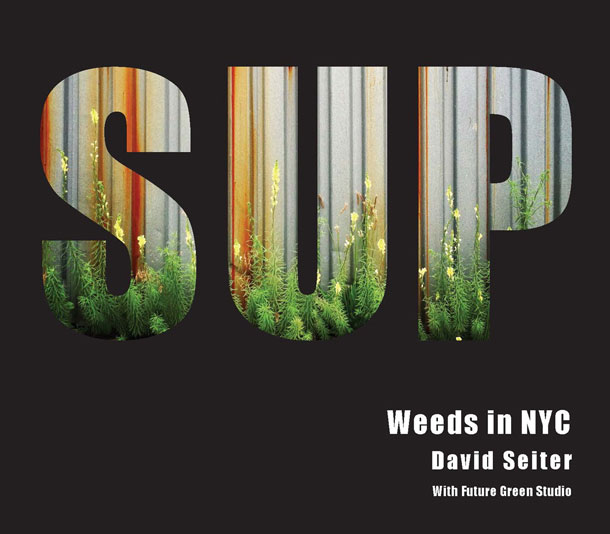
The inspiration for the book “Spontaneous Urban Plants: Weeds in NYC” came from an Instagram-powered art and research project, #spontaneousurbanplants, on the overlooked ecological services that weeds offer in urban environments. (Photo: Future Green Studio)
[DOOR OPENS INTO THE OUTDOORS]
SEITER: We can walk on the shady side or the weedy side. They’re kind of everywhere.
PALMER: Outside on the street, a riot of spontaneous urban plants sprouts up along and through the cracked sidewalks of Redhook. There’s Queen Anne’s Lace, Bittersweet Nightshade, and the ubiquitous Ailanthus, the Tree of Heaven.
SEITER: This plant is also called the tree of Brooklyn, because it was made famous by the book "A Tree Grows in Brooklyn." Ailanthus was intentionally cultivated in the 70s and I think as late as the early 80s, and then they realized its invasive potential, and the fact that is was starting to kind of grow in areas that we really didn't want it to grow. But since it’s become kind of the poster child of weeds, and right now this plant is covering New York City as well as other cities. Yet people aren't really calculating it in their index of urban trees yet there's a forest of them. They just are happening in these more discrete locations, and in locations that we don't really qualify as green space. Things like walls, and streets and sidewalks and roofs. But you really find them as kind of this emergent vegetation everywhere.
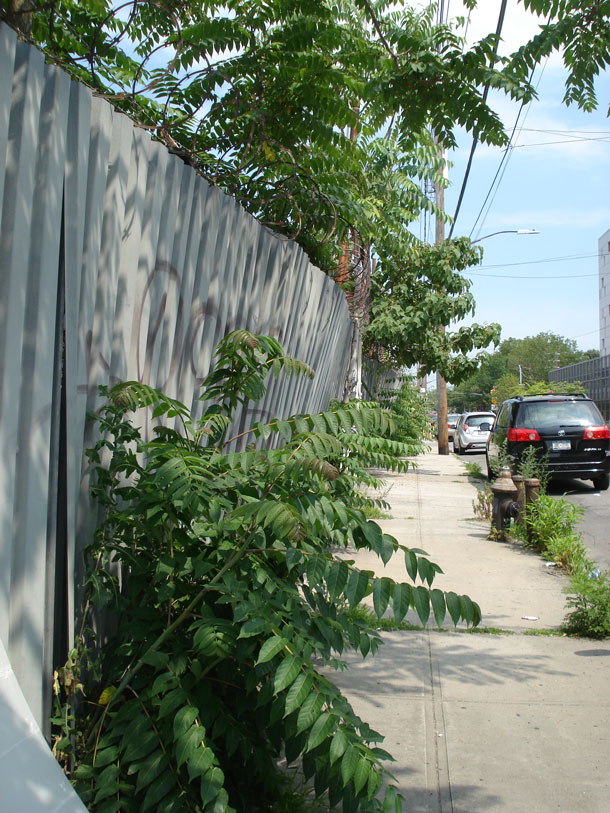
Ailanthus altissima, commonly known as “tree of Heaven”, is a familiar part of American culture thanks to the best-selling novel “A Tree Grows in Brooklyn.” (Photo: Helen Palmer)
PALMER: As we walk, David points out several other weed species: Lambsquarters, horsetail, and the leafy Boston ivy vine, crawling up an abandoned brick warehouse.
SEITER: Because it’s growing on this wall in this neglected space people perceive it as a weed. The same thing happens with Goldenrod, one of my favorite native plants, if you find that in a garden you say ‘what a beautiful flower,’ but when you find it on a vacant lot you're thinking ‘oh it’s coming out at the same time as ragweed, it’s causing hayfever.’ There’s all these negative associations with it.
PALMER: We sit down on a shady park bench under a linden tree, and David talks about his new book. It’s a guide filled with photos and a list of the benefits of these neglected tough plants with names like fleabane, common toadflax, and broadleaf plantain – all of them weeds to most gardeners.

“Nowadays” is a new outdoor hangout spot in Queens, built on a former industrial site and designed by Future Green studio. (Photo: Future Green Studio)
SEITER: My intention is to really rebrand weeds and get people to think about their ecological and performative values. So, we wanted to use the title SUP (Spontaneous Urban Plants) to get people's attention, and really get them to think about what plants might be acceptable in an urban environment.
PALMER: So how did this whole idea of rebranding plants come about? What started it off?
SEITER: Well, we originally worked on a design competition where we wanted to engage the city in a unique way. So what we did was establish transect walks across each of the five boroughs here in New York City and went out in small teams to kind of document the urban plants that we found along the way – then use the digital tool of Instagram to photograph the plants, use the filters available to sensationalize the plants and again, elevate their status and reveal their potential beauty.
PALMER: So basically people sent you snapshots of the weeds they found as they wandered through the city?
SEITER: Right, essentially it is a user-generated database of weeds. So you can go on Instagram, take a picture of an urban weed, hashtag it “spontaneous urban plants.” It gets mapped to our website where we identify it and we've really now created this kind of worldwide mapping of weeds, and what's really fascinating and something that has come out of that research is that there's actually an urban flora which is starting to emerge that is almost like a native condition. It's less about the climate of that particular city or region and more about the urban conditions which it offers. So the same 150 to 200 plants that are growing here New York, many of them are being found in Berlin or in Seoul, South Korea or in the Netherlands. So it's fascinating to see that the urban conditions rather than climate have really started to generate which plant communities exist there.
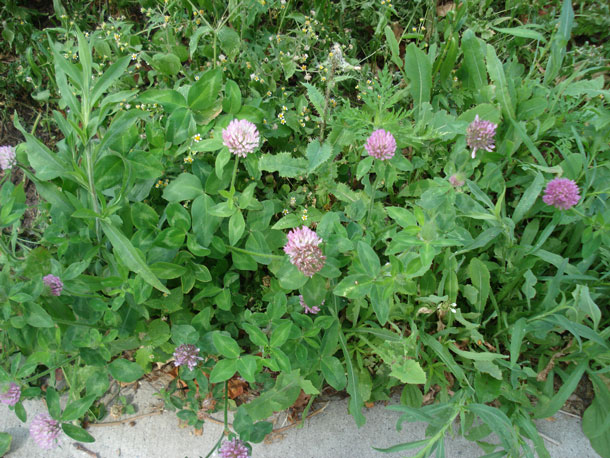
Red clover fixes nitrogen in the soil, helping other plants grow (Photo: Helen Palmer)
PALMER: Now, talking about the kind of weeds, you've got many many different ones...what do you think is particularly lovely, particularly beautiful that we could really look at a little more carefully and not just call a weed?
SEITER: Well, there's so many [LAUGHS]. Where should we choose from? Goldenrod is one of my favorite. White clover I think is a wonderful plant to come and invade our parks and lawns. Red clover is another beautiful plant and it's got night nitrogen capabilities and therefore has got some great additive benefits to our soil. Queen Anne's Lace is such a beautiful plant that is just starting to emerge right now.
PALMER: But some of them are what we would call invasive. Some of the ones you have on your list. I mean, let us take the ubiquitous weed, the phragmites.

Fleabane is a spontaneous urban plant in the daisy family (Photo: Helen Palmer)
SEITER: Yes, the worst of them, and I think if you look at the plants that are on the invasive list here in New York State, you're looking at mugwort, Japanese knotweed, phragmites. Each of the plants really need to be studied, I think, further by botanists and urban ecologists to really understand and parse out what benefits those plants have and which ones they don't.
PALMER: So, taking that as your basis that there can be some benefits to these weeds, what I would call weeds, like mugwort, what would you call their benefits?
SEITER: They offer all sorts of ecological services. In certain conditions they would offer erosion control. They can offer noise mitigation. There's storm water management qualities that they can offer. If you look at, for example, common reed or phragmites, it's appearing in many places where traditionally we would've found cattails, right? Both plants have incredible filtering properties as plants themselves. The phragmites, although it establishes these rampant monocultures and does have degrading effects on more naturalized areas, at the same time it offers a lot of value in treating and filtering out the polluted water that it comes in contact with. So we really have to think site by site, where is that plant potentially going to do us good, and does that plant have the ability to kind of jump from an urban condition to a more naturalized condition. And perhaps the plants that are taking those leaps are the ones that we really should be looking at trying to eradicate. But the plants aren't here just because they want to be here, they're here because our conditions are degraded. We're not really fostering the native Northeast deciduous forest conditions, or here in New York the kind of tidal estuary conditions that we would've traditionally found. What we've created is a fully-altered, integrated system that the plants are really just responding to and kind of taking advantage of. I think spontaneous urban plants are actually giving us a great indicator of what plants might be successful in the future. Their resiliency in the urban environment really mimics the kind of resiliency that we're going to expect our plant life to have in the future.

Broadleaf plantain sprouting in a sidewalk crack (Photo: Helen Palmer)
PALMER: Or we're going to need our plant live to have in the future in fact.
SEITER: Absolutely, and if we think about our cities and the different types of cities that we have, most of the rapidly growing cities are in our global south, in Asia, South America and those cities are hyper-dense and they're pretty much devoid of vegetation. So we want to look at every unique opportunity to kind of weave in, planted or unplanted landscapes to create more livable cities.
PALMER: A lot of these plants – as you say – you can eat them, though probably the ones that are growing on the sidewalk you wouldn't want to eat. But what other benefits do they have? You talk about their ability to soak up rainwater. You talk about their ability to clean up the soils.
SEITER: I think another thing that we should be thinking about is carbon sequestration. Although many ecologists will say you really need a forest of trees to be able to effectively sequester carbon in the urban environment, I would argue we have a forest of spontaneous trees that are really growing and they're not documented or mapped. Nobody's really understanding how many of them there are, so if we can start to lend a hand towards understanding that system in greater detail, I think we could make a case that they're actually performing great carbon-capturing effects.
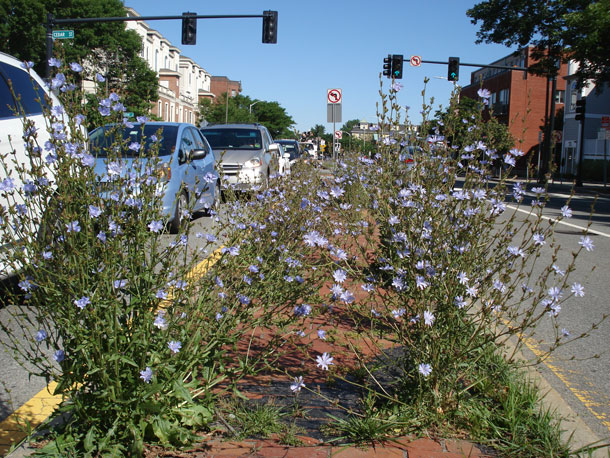
Chicory spontaneously grows up from the bricks along the median of Cambridge’s Massachusetts Avenue (Photo: Helen Palmer)
PALMER: So, things like the Tree of Heaven, the tree that grows in Brooklyn, but basically as reviled as weed trees, you would say are weed trees with a particular value.
SEITER: I would and I actually appreciate their aesthetic value as well. They're kind of wonky, gnarled trees that have a particular character and quality so again, on the right site I think that they're really effective plants.
PALMER: Do you find that, in fact, the authorities agree with the value of what you call urban plants, what other people call weeds?

Lamb’s quarters growing along a Brooklyn sidewalk (Photo: Helen Palmer)
SEITER: It's a topic that they're beginning to be more receptive to. One of the biggest things that is facing New York City parks here in general is that each park gets a grade from the kind of central dispatcher about how well their park is maintained, and unfortunately one of the biggest qualifying factors is the amount of weeds that are present. So, the parks has unfortunately set up this system where weeds are essentially looked at negatively. I was recently in discussion with the head of horticulture for the New York City parks and she was really open and receptive to the idea of certain wild, urban plants growing in parks but she was worried about the public perception of those plants because when people see overgrown weedy landscapes they think it's derelict or neglected, and parks management officials are essentially given poor management grades when weeds are allowed to kind of grow in their parks. So, if we're going to rethink weeds themselves, I think we will also need to get our parks department to rethink how they're valuing the management of their open spaces.
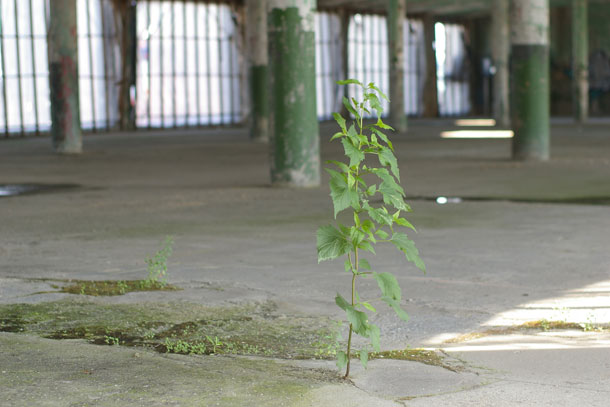
Ageratina altissima or White Snakeroot (Photo: Future Green Studio)
PALMER: If you actually rethink weeds you can actually see that the beauty of them, the benefits of them and actually remake our landscape?
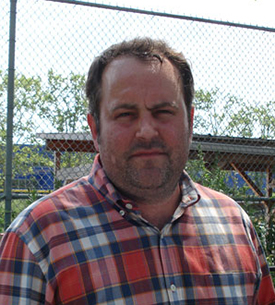
David Seiter is design director and founding principal of Future Green Studio in Brooklyn, New York. (Photo: Helen Palmer)
SEITER: Yes, I think we have the potential to do all of that. I mean, again, our perception of weeds are just really like a cultural perception. There's no particular reason why many of these plants are called weeds except they are kind of growing in places that we don't necessarily want them to grow. So if we just kind of expand our definition of what's acceptable, I think that we'll find many of these plants offer this kind of hidden or overlooked ecology to the city.
PALMER: My mother used to say, “a weed is just a plant in the wrong place.”
SEITER: Absolutely. And then in my own little Brooklyn backyard I find a fig buttercup drifting in white snake roots. These plants that are spontaneously growing but that I appreciate the value of and create this kind of carpet of yellow and white and red throughout the seasons. So I’m teaching my own kids to think about the value of those particular plants.
CURWOOD: That’s landscape architect David Seiter, in Brooklyn with Living on Earth’s Helen Palmer. His book is called "Spontaneous Urban Plants, Weeds in NYC.”
Related links:
- Future Green Studio
- Check out David Seiter’s book
[MUSIC: Brad Paisley Band, “In the Garden,” Who Needs Pictures, C. Austin Miles, Arista Nashville
https://www.youtube.com/watch?v=lM_nEZbIISc]
CURWOOD: Coming up...how music can help kids care about nature. That’s just ahead here on Living on Earth. Stay tuned.
ANNOUNCER: Funding for Living on Earth comes from you our listeners, and United Technologies – combining passion for science with engineering to create solutions designed for sustainability in the aerospace, food refrigeration ,and building industries. UTC companies such as Otis, Carrier, Pratt & Whitney, and UTC Aerospace Systems are helping to move the world forward.
This is PRI, Public Radio International.
[CUTAWAY MUSIC: Brad Paisley band featuring Glen Duncan, “In the Garden,” Who Needs Pictures, C. Austin Miles, Arista Nashville. https://www.youtube.com/watch?v=lM_nEZbIISc]
Roadsides as Vital Habitat
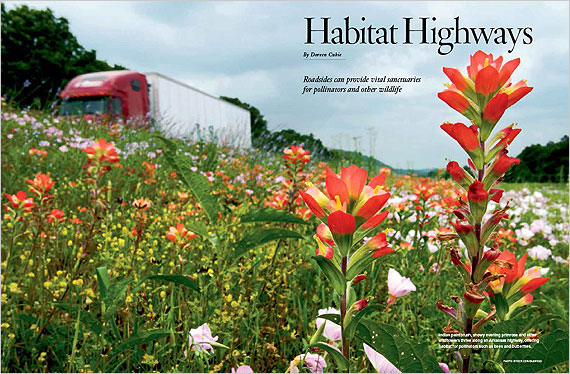
The National Wildlife Federation recognizes roadsides as vital sanctuaries for pollinators and other wildlife. (Photo: courtesy of NWF)
CURWOOD: It's Living on Earth, I'm Steve Curwood. Those so-called Spontaneous Urban Plants can offer us unappreciated benefits as do the miles of medians and roadsides along our highways. All those broad green highway rights of way turn out be vital habitats for many small critters, as well as pollinators including bees, butterflies and birds. Bonnie Harper-Lore was a restoration ecologist for the Federal Highway Administration, and now a member of the Commission on Minnesota Resources. Welcome to Living on Earth, Bonnie.
HARPER-LORE: Greetings, Steve, how are you?
CURWOOD: Good. Thanks for joining us today. Now, we're talking about those strips of vegetation along the highways. There's often commercial or residential property right behind them. So, nationwide, just how much of this habitat is there?
HARPER-LORE: Well, I think the listeners will be surprised to find out that the area between the pavement and the right of way fence on county, state, and interstate highways adds up to a total of 17 million acres, possibly millions of acres of conservation opportunity.
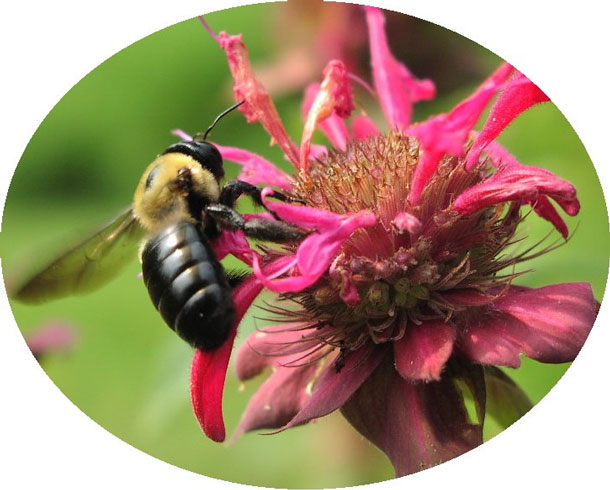
Bees are some of the pollinators that depend on roadside habitat. (Photo: Beatriz Moisset / USDA)
CURWOOD: You know, recently we saw National Pollinator Week, which was a time to celebrate the pollinators, spread the words about what people could do to protect them. So what we have to celebrate in terms of roadside habitat for pollinators now?
HARPER-LORE: Well, the fact that it’s a news item at all is something I'm celebrating because I always saw roadsides from the beginning of my career 30 years ago as an opportunity to benefit wildlife, small wildlife, small birds, small mammals, and migrating birds also use these same corridors. So if they have places to find food and cover, they are all going to do better and their populations will continue to hold where we need them to hold.
CURWOOD: By the way, I also understand that this roadside habitat has some of the most endangered habitat in various areas – like there are parts of the original prairie that are protected alongside roads, sort of by accident. You can sometimes find real old-growth trees. I mean, how much of a treasure trove is this territory?
HARPER-LORE: Well that's just it: We don't have a complete inventory of all of our roadside vegetation. I would indeed like to see that happen because I think we would be surprised at how many remnants of these old forests, old prairies, old wetlands even do exist. We began doing a bit of that inventory in 1993 in California – found 19 remnants within a very short time and began protecting them, managing differently, not mowing and spraying as they had in the past. So there are some of these. I mean, it's surprising that they do exist. I know Florida has also some endangered, I believe, pitcher plants that are growing in their rights of ways and they are now watching over them differently than they have in the past. So if we know they're there we can do differently.
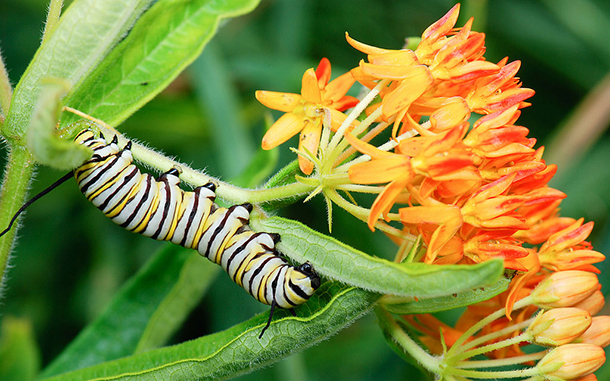
Monarch butterfly caterpillar feeds on milkweed. Along Interstate Highway 35, a 1,568-mile-long road between Duluth, Minnesota and Laredo, Texas, Monarch habitat is being preserved. (Photo: Marshal Hedin, Flickr CC BY-SA 2.0)
CURWOOD: So, give us the big picture as to who are the partners in these pollinator conservation efforts.
HARPER-LORE: Well, first of all, before President Obama visited Mexico and talked to President Nieto and Prime Minister Harper from Canada and they agreed to work together to protect Monarchs –before that point there were actually a few states that were doing pollinator-focused efforts. Wisconsin comes to mind in that the Karner Blue butterfly is an endangered species and they actually put together, I believe, a 20 member partnership quite a few years ago to protect the Karner Blue and that partnership was mostly private sector but some state and county agencies, too, and they've done a great deal to keep the Karner Blue safe in Wisconsin. So those kinds of things have happened individually but you have to realize every state Department of Transportation basically does its own thing, makes it own priorities but now. Now that there's been a White House task force there has been a pollinator-enhancing bill, a reauthorization act that actually supports pollinators, all of the states will start moving in that direction, especially if they know the public is interested. So public support needs to be there.
CURWOOD: Tell me about the multistate project known as the I-35 corridor, and what's been done in terms of Monarch protection there?
HARPER-LORE: Well, ironically back in 1993, a group of six states asked the Federal Highway Adminstration, where I worked at the time, to work together and get some funding to support their effort to actually restore prairie along the I-35 corridor and to protect any remnants that already existed there.
CURWOOD: And remind us where the I-35 corridor is.

Ladybird Johnson, First Lady during the Lyndon Johnson administration of the 1960s, spearheaded the Highway Beautification Act. (Photo: Frank Wolfe / LBJ Library, Wikimedia Commons Public Domain)
HARPER-LORE: It runs from Minnesota through Iowa, Kansas, Missouri, Oklahoma and Texas, therefore connecting Mexico to the edge of Canada and of course that's where the Monarchs fly.
CURWOOD: What other wildlife uses this roadside habitat? You know, you often see hawks hanging out there. The hunting must be pretty good for them, I guess?
HARPER-LORE: It certainly is. I watched hawks, all kinds of raptors, sitting on the light standards along highways and signposts just waiting for lunch to materialize down there in the vegetation on the roadside. Yes, they do well there because there are lots of mice and voles, other small things possible, plus one that actually motivated reduced mowing here in the Midwest, pheasants and other waterfowl, different kinds of ducks will nest in these rights of ways. So, it's amazing, when you're screaming by at 55 to 70 miles an hour, what's happening out on that green strip that you probably will never ever imagine.
CURWOOD: Lady Bird Johnson, first lady during the Lyndon Johnson administration, her signature cause was highway beautification back there in the 60s. What kind of impact – what kind of lasting impact – has her work had on roadside pollinators do you think?
HARPER-LORE: Well, I smile because it's because of Lady Bird Johnson that my job even existed with the Federal Highway Administration. I was working for the Minnesota Department of Transportation establishing their wildflower program back in the 1980s when I got an invitation from Mrs. Johnson to come visit with four other states who were also interested in planting wildflowers and we sat and talked with her for two days, and the thing we didn't know she would do -- because she asked us what did we need to be able to do more -- within that same year, she saw to it that there was an amendment to the transportation bill that requires all states to use certain percent, not a large enough percent, but a certain percent of their budgets on native wildflowers. So, a few years later, I was looking for a job and I talked to the people I had met at Lady Bird Johnson's and they said there's an opening in Washington and within a few months I was able to be in charge of the national wildflower program. Thanks to her, we've come some distance. I've had people write me with their thank yous for the wildflower program over time. One of them was an 18-wheel truck driver who said, ‘thank you for the wildflower program, I drive from coast to coast and it helps me...gives me something to look at and keep me alert and awake’, and I was like, ‘what a surprising thank you letter that was.’ And there are others too. I have a file full of them.
CURWOOD: Bonnie Harper-Lore served in the Federal Highway Administration as a restoration ecologist. She is now with the Commission on Minnesota Resources. Bonnie, thanks for taking the time with us today.
HARPER-LORE: You're welcome. Thank you for what you do.
Related links:
- The I-35 Corridor To Become a Habitat For Bees, Monarch Butterflies, and Other Pollinators
- A Transportation Research Board webinar about how roadside mowing affects pollinators
- Bonnie Harper-Lore serves on the Legislative-Citizen Commission on Minnesota
- Tips for preserving roadside habitat from the Xerces Society for Invertebrate Conservation
- Green Highways: New Strategies To Manage Roadsides as Habitat
[MUSIC: The Hot Sardines, “Bei Mir Bist Du Schoen,” The Hot Sardines, S. Secunda/S. Cahn/S. Chaplin/J. Jacobs/D. Fields/J. McHugh, Decca/Universal Music Classics
https://www.youtube.com/watch?v=Q4-XIKt-ADs]
Whizpops: Teaching Science to Kids
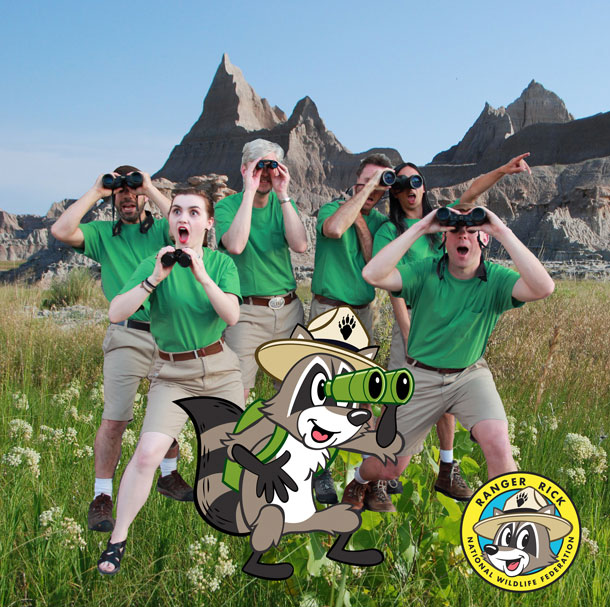
The Whizpops are based in Missoula, Montana (Photo: The Whizpops)
CURWOOD: More than 2,000 endangered and threatened species are listed under the U.S. Endangered Species Act, and some Montana teachers in Missoula are using music to teach young children about the many creatures at risk. They call their award-winning band The Whizpops! and their latest album of science-based songs is called Ranger Rick’s Trail Mix Vol. 1, and it’s just out. Band leader Casey Schaefer is a kindergarten teacher and joins me now. Casey, welcome to Living on Earth.
SCHAEFER: Thanks, Stephen. Nice to be here.
CURWOOD: Hey, let's start by listening to part of your song about the American bison which President Obama recently named the national mammal of the United States.
SCHAEFER: Yes.
[MUSIC: The Whizpops!, “Bison,” Ranger Rick’s Trail Mix No.1, Stretch McCoy Records/National Wildlife Federation]
CURWOOD: Whoa, that's a dance tune! So why the bison, and what is it about that animal that made you choose it?
SCHAEFER: Well, as we were creating the album and thinking about endangered species to write about, we were trying to align our mission with the National Wildlife Federation’s mission and they've been putting a lot of resource and time and effort into protecting the American bison and so we decided that we're going to write a song about them and kind of honor them and their history in this country which it's pretty sad and hopefully the song gives a feeling of hope and thankfulness that they're still around and that we can preserve their legacy.

The Whizpops released their newest album, “Ranger Rick’s Trail Mix Vol. 1,” on May 20th, Endangered Species Day. (Photo: The Whizpops)
CURWOOD: So how did you choose the other animals that are featured on your CD?
SCHAEFER: We were basically looking at animals that were either endangered or threatened or endangered of becoming threatened because of human impact and climate change and whatnot.
We looked at all that – whatever was inspiring to us at the moment. Say, there's a song we have written, and a riff or piano riff, and you kind of try to match up to what you think of – the character of animal that would best represent that music and so that was the case of California Condor. There's this kind of mysterious sounding part at the beginning and then it opens into this soaring, graceful feeling, and kind of helped us pick that animal for that particular song.
[MUSIC: The Whizpops!, “California Condor,” Ranger Rick’s Trail Mix No.1, Stretch McCoy Records/National Wildlife Federation]
CURWOOD: Well, you know these animals that you're singing about are in various levels of trouble, but the music is not dark, it's not gloomy. There is a beat to it and you can move to it.
SCHAEFER: Yeah, I think that's a great way to describe it. We try to make the music engaging and kind of exciting to listen to for kids and adults and for ourselves. There will be parts in songs that might have a minor or darker sound but they're not depressing. We're not trying to bring anybody down with the music. We're trying to get people excited to learn about these animals and help conserve them in a way.
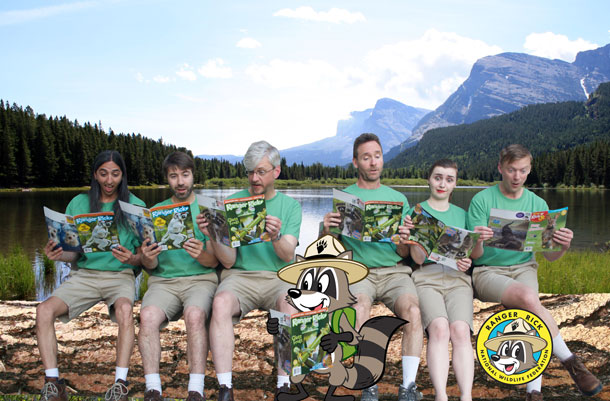
Casey Schaefer started the Whizpops with another elementary school teacher, Kevin Cashman (Photo: The Whizpops)
CURWOOD: So, tell me, how did you get started writing science-based music for kids?
SCHAEFER: Well, my first year teaching kindergarten nine years ago, we were doing a unit on owls towards the end of the year and I was just trying to pull in as many resources as I could find. I’d acquired basically a huge treasure chest full of wonderful owl artifacts – talons and skulls and wings and feathers – all kinds of great things. And the only thing that was missing really was music, and as a musician, somebody who plays music for kids every day, I noticed that hole and I wanted to fill it. So I called up a friend of mine who I've gone to school with. He was also a teacher and I said, ‘I really want write a song about owls. Will you help me out?’ He was, like, ‘sure what are you doing tonight?’ I said, ‘nothing. Let's do it.’ So I went over to his place on a Friday night. We sat down and within a couple hours we had written and recorded the owl song in his basement studio.
[MUSIC: MUSIC: The Whizpops!, “The Owl Song,” The Adventures of Stretch McCoy, Stretch McCoy Records]
SCHAEFER: And that was the beginning of the Whizpops!. We didn't know it at the time, but that's where it all started, and why it all started. And all the music since then has come to come from that place of trying to fill a niche that we feel maybe has been missing to help enhance students’ learning.
CURWOOD: Well, how have kids responded to all of this?
SCHAEFER: Well, when I first played in the owl song I kind of did a test because I was curious myself. I had recorded the song. I played it for them live first. And after I played it for them, I asked them questions about what they learned in the song, and they basically regurgitated the entire song, and I was blown away. I had no idea they would be that interested in it or that they would be able to recall the information that readily, and something clicked right there, and from that point on every time we wrote a song, I figure we looked at in a different way because we knew that this is actually meaningful and it would work. This last album, the kids have latched onto the lyrics faster than any other song or any other album that we've written before, so that's pretty exciting to see.
CURWOOD: Alright, let's try another song, your Monarch butterfly song. Let's take a listen.
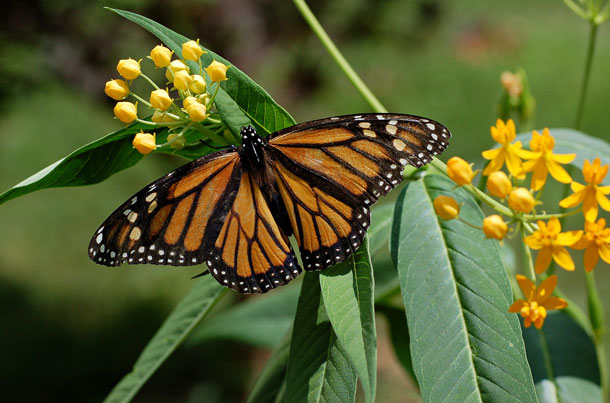
The album teaches kids about the importance of the milkweed plant to the monarch butterfly. (Photo: Derek Ramsey, Wikimedia Commons GNU free documentation license)
[MUSIC: The Whizpops!, “Monarch”, Ranger Rick’s Trail Mix No.1, Stretch McCoy Records/National Wildlife Federation]
CURWOOD: “Milkweed is what I need to succeed!” Bob Marley channeled through a Monarch butterfly, huh?
SCHAEFER: [LAUGHS] Yeah, I guess so.
CURWOOD: Why the Monarch?
SCHAEFER: Well, that's another species that the National Wildlife Federation is working really hard to save. If you look at the data, since the 90s, about 90 percent of the Monarch butterfly population has been decimated through loss of food, the milkweed, through pesticides. Human activity has really kind of devastated their population, and it's one of those species you know people can actively get involved with helping to save. If you live in an area where you have Monarchs – and that's a good portion of the United States – it's really easy to get outside and plant some milkweed plants. Those caterpillars, they will only eat milkweed. I thought I was picky eating as a kid!
CURWOOD: Hey, Casey, how do you juggle the music with your role as a kindergarten teacher? How do these things work together? If we were talking science I guess we could talk about symbosis here or maybe not?

The Whizpops collaborated with the National Wildlife Federation for their newest album. (Photo: The Whizpops)
SCHAEFER: Sure. So, like I said I incorporate music in my classroom in just about any way possible. Whether it's taking a Shel Silverstein poem and putting a melody to it, or transitioning from one activity to the next in kindergarten. I'm picking up the guitar, we're singing about it, the kids come up and make up songs and we just have a really fun time with it. The kids are a kind of a great litmus test too for the music and they really enjoy it and they were actually on this CD, on our wolverine song they are singing in the background.
[MUSIC: The Whizpops!, “Gulo Gulo (Wolverine),” Ranger Rick’s Trail Mix No.1, Stretch McCoy Records/National Wildlife Federation]
SCHAEFER: We just recently played our CD release party and all the kids in the class came up on stage to sing with us and so it's really fun to come to bring them into this world and so they can see kind of the process from writing a song or thinking of an idea for a song, writing it down on paper, typing it up, recording it and then performing it – to kind of get to see behind the scenes and the finished product. And I think that's important for them to see, you know, how something is made. And several of my kids have already started writing their own songs. Every year, at least three or four kids beg for a guitar for Christmas and that's really cute. And they'll bring their guitar and they'll play for the class and so it's really neat to see how that all plays out in their eyes.
CURWOOD: Hey, before you go Casey, I'd like to end with your song about the pika.
[MUSIC: The Whizpops!, “Pika,” Ranger Rick’s Trail Mix No.1, Stretch McCoy Records/National Wildlife Federation]
CURWOOD: So, tell me a little bit about the pika and why you chose this animal for a song?

Album proceeds will go towards wildlife conservation efforts. (Photo: The Whizpops)
SCHAEFER: Well, they're an amazing creature and not a lot of people know about them because there's not that many left in the world. You rarely see them. You might hear them. They’ll basically run around all day gathering plants and they'll make what’s called a hay pile and they will stash them under the rocks because in winter time they’ll eat them. Kevin and I were hiking in Glacier years ago and we ran into one. It was right there by the trail and they're just about the cutest animal you can imagine. It kind of looks like a cross between a bunny rabbit and a mouse, but they are an indicator species for climate change. If it gets too warm, they're not able to survive. Their bodies can't withstand that warmer temperature. So with the current climate change that's happening, it's been hard on their species. We're trying to raise awareness about the pika and climate change, not in an in-your-face kind of way. We don't say anything about climate change really in the song. We just want to get kids and adults interested in learning about these animals so that they can potentially help save them some day. Seeing them live in the wild and knowing kind of the situation that they're in is sort of the inspiration for that song.
CURWOOD: Casey Schaefer is a kindergarten teacher in Missoula, Montana. Hey, thanks for taking the time today, Casey.
SCHAEFER: Thank you, Steve.
[MUSIC: The Whizpops!, “Black Footed Ferret,” Ranger Rick’s Trail Mix No.1, Stretch McCoy Records/National Wildlife Federation]
CURWOOD: That’s the Black-Footed Ferret song. There’s more about the Whizpops’ music at our website, LOE.org.
Related links:
- The Whizpops official website
- Like the Whizpops on Facebook
- Buy “Ranger Rick’s Trail Mix Vol. 1” on iTunes
- Music video for “Black Footed Ferret”
Living on Earth is produced by the World Media Foundation. Our crew includes Naomi Arenberg, Bobby Bascomb, Jenni Doering, Anica Green, Jay Feinstein, Emmett Fitzgerald, Jaime Kaiser, Don Lyman, Helen Palmer, Charlotte Rutty, Adelaide Chen, Jennifer Marquis and Jolanda Omari. Tom Tiger engineered our show, with help from Jeff Wade, Jake Rego and Noel Flatt. Alison Lirish Dean composed our themes. You can find us anytime at LOE.org, and like us, please, on our Facebook page – it’s PRI’s Living on Earth. And we tweet from @LivingonEarth. I'm Steve Curwood. Thanks for listening.
ANNOUNCER1: Funding for Living on Earth comes from you, our listeners, and from the University of Massachusetts, Boston, in association with its School for the Environment, developing the next generation of environmental leaders. And from the Grantham Foundation for the protection of the environment, supporting strategic communications and collaboration in solving the world’s most pressing environmental problems. Support also comes from the Energy Foundation, serving the public interest by helping to build a strong, clean, energy economy, from Gilman Ordway, and from SolarCity, America’s solar power provider. SolarCity is dedicated to revolutionizing the way energy is delivered by giving customers a renewable alternative to fossil fuels. Information at 888-997-1703. That’s 888-997-1703.
ANNOUNCER2: PRI. Public Radio International.
Living on Earth wants to hear from you!
Living on Earth
62 Calef Highway, Suite 212
Lee, NH 03861
Telephone: 617-287-4121
E-mail: comments@loe.org
Newsletter [Click here]
Donate to Living on Earth!
Living on Earth is an independent media program and relies entirely on contributions from listeners and institutions supporting public service. Please donate now to preserve an independent environmental voice.
NewsletterLiving on Earth offers a weekly delivery of the show's rundown to your mailbox. Sign up for our newsletter today!
 Sailors For The Sea: Be the change you want to sea.
Sailors For The Sea: Be the change you want to sea.
 The Grantham Foundation for the Protection of the Environment: Committed to protecting and improving the health of the global environment.
The Grantham Foundation for the Protection of the Environment: Committed to protecting and improving the health of the global environment.
 Contribute to Living on Earth and receive, as our gift to you, an archival print of one of Mark Seth Lender's extraordinary wildlife photographs. Follow the link to see Mark's current collection of photographs.
Contribute to Living on Earth and receive, as our gift to you, an archival print of one of Mark Seth Lender's extraordinary wildlife photographs. Follow the link to see Mark's current collection of photographs.
 Buy a signed copy of Mark Seth Lender's book Smeagull the Seagull & support Living on Earth
Buy a signed copy of Mark Seth Lender's book Smeagull the Seagull & support Living on Earth

